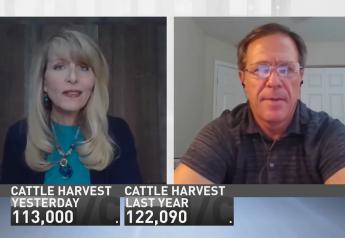Ferrie: Here's How to Set up Your Fall Tillage Tools for Success

With harvest 2023 in the rearview mirror, growers are working to get their fall tillage practices completed.
In this week’s Boots In The Field podcast and in the two videos below, Ken Ferrie explains how to successfully set and operate your hybrid chisel and inline ripper.
Hybrid Chisel
“The primary pass in the fall has to be done right for vertical till to be successful,” says Ferrie, Farm Journal Field Agronomist. “For you guys who are doing primary tillage in the fall and following it with horizontal tillage in the spring, it's not quite as crucial. You're going to take care of those issues if you don't get full-width shatter with your disk or soil finisher in the spring.”
When Ferrie mentions full shatter, he’s referring to the top 4” to 6” of the soil. “Typically, this is going to be a function of depth and shank width,” he says. “A good rule of thumb is half your shank width is the depth the tool is going to have to be pulled at.”
One of the challenges growers run into, for instance, with a 510 disk ripper on 30-inch centers, is the depth requirement to get full shatter for those tools is almost out of their horsepower range.
“The situation with those tools is that they are designed for conventional tillage where you can come back and take out the untilled part with your finishers with your disk in the spring. As we look at vertical tillage, we typically look at shanks that are closer together. Today the hybrid chisels are looking at 16-inch spacings on the shank, letting us go 8” or 9” deep, shallowing up some so on we can pull it and get full shatter, but we still have to have residue flow. So it's a design issue there as far as depth of the frame and length and to get 200-plus bushel residue through the machine itself.”
In the following Setting Your Hybrid Chisel video, Ferrie and his agronomic team at Crop-Tech Consulting demonstrate two different vertical tillage tools. Both are what Ferrie calls hybrid chisels, but their designs are different.
One of the tools is set up to bury residue. “As we think about what we want to do, we've got to have full shatter no matter what we're doing. Then the question is, how much residue do we want to bury or put in the ground itself,” he says.
The second tool has straight cutters on the front. “And those straight cutters are designed just to size residue, so it'll flow through the machine and stay on top. That would be something that we'd run in the bean stubble, for instance, and want for residue cover,” Ferrie explains.
Who would buy these tools, what would make a difference? "Well, definitely when we're talking about the straight cutters, leaving lots of residue on top, that's a tool that's really loved by the growers that are doing no-till," he says.
“If I'm a no-tiller, and I like my residue on top, I like my ground protected, I can use this tool to fix ruts in the field from sprayers or other problems,” Ferrie adds. “Definitely we can use them to fix pH problems if we're incorporating limestone, so we can get the tillage and we can get some mixing action down below but still have some residue for cover on top. So we can get back into a no till program as fast as we can and keep that bean stubble from blowing away on us in the spring.”
Now the second tool that buries residue, again, that's the kind of tool that corn-on corn growers like.
“They like to tuck and bury some of that residue in so it can decompose and get out away. So they don't have to deal with it in their corn-on-corn program. It's also one of the ways that we manage disease. In disease problem fields, we can bury some of that residue and move that residue along faster to get rid of it. It really comes down to which tool you're going to buy and how much residue you want left on top,” Ferrie says.
Inline Ripper
In the second video, Ferrie and team want to make sure that as inline rippers start rolling that they’re used successfully for the job intended.
“The first thing we have to consider when we take an inline ripper to the field is to make sure that we have reason to be out there,” Ferrie says. “This is a situation where today in the YouTube video, we're going to be in corn stalks. And most of you know that our data says it's kind of hard to make tillage pay for itself ahead of soybeans.”
In this particular field, though, Ferrie and team are fixing a couple of problems.
“We've got a substantial amount of density layers and to the point where they're stopping roots,” Ferrie says. “We've identified this and we do need to take those layers out. We also had some traffic in this field due to pipeline and pipeline traffic. We're going to try to reset this field so we can put it on its way back to uniform density.”
Watch the How to Set An Inline Ripper video.
Once again, Ferrie says complete shatter must be achieved. “We need a uniform seedbed, we need a uniform shatter to get that done. And if we're going to level with our harrows remember harrows level from the top, not from below. So that's going to be part of why this is different for you guys in vertical tillage compared to you guys that are in a horizontal tillage program.”
Test Plot Results
The Farm Journal Test Plots have been harvested. Ferrie shares some initial insights in this week’s podcast:







